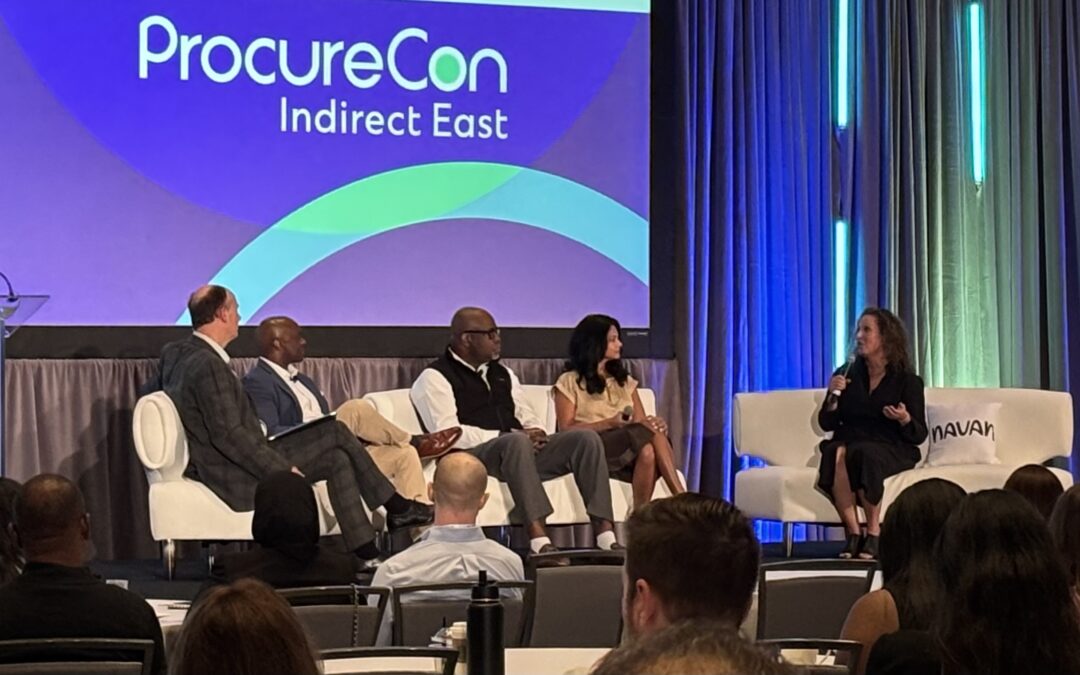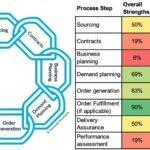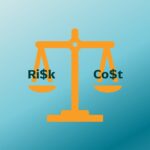I like conferences. Even when I’m still recovering from a cold and wedging a conference in between personal and client trips, they’re a good chance to expand my network, learn what’s “hot” and what’s “not,” and step a little outside my standard routine. For many years I worked for companies that simply didn’t attend conferences for one reason or another. So this week I’m spreading the learnings from ProcureCon Indirect East in Orlando last week, focusing on the opening keynote panel on “Leading Teams Through Uncertain Times,” and an excellent little session on the hottest of topics: managing tariffs. I’ll also express some thoughts on ProcureCon vs. ISM.
Leading Teams Through Uncertain Times
The opening keynote panel was moderated by Graham Crawshaw of CASME and included Egwu Nwankpah of Cushman & Wakefield, Shereen Lannoye of Atellas Pharma, and Aleck Matambo of BHAG AI Advisory. They started off talking about celebrating wins, which made me chuckle when the quote-of-the-day in my planner was “Celebrate what you want to see more of.” by Tom Peters. My biggest takeaway from this section was: don’t wait until the end to celebrate. Sometimes the end is a long time down the road on a big project, so that end celebration seems like too little, too late. Celebrate some of the middle wins – milestones reached, small victories, and human moments.
Then the conversation turned to soft skills as really seeing a resurgence. After COVID, we’ve all had to re-learn how to meet someone in real life (a very tall panelist upon meeting people in person: “Hey there! Yes, I’m tall!”). The panel also emphasized that the need for empathy has changed in the workplace. Peoples’ commutes are long, and we’ve sometimes forgotten how to address each other in person. We must have empathy and grace for what our coworkers are struggling with and that we are all stressed. Being a conference focused on indirect procurement, the panelists mentioned our stressed stakeholders usually don’t give us enough requirements in their scopes of work and we have to use our soft skills to pull out the remaining details.
Next the talk shifted to business continuity. Mr. Cranshaw quipped “If we got to a stable environment, procurement wouldn’t know what to do.” The panel talked about the importance of a risk plan, including all risks, not just the “loud” ones. For each risk, make a contingency plan. The panelists also noted the importance of pulling together an outside-the-box team of creatively-minded people, especially to attack an immediate crisis in the short-term. End-to-end visibility is still the best way to mitigate risk, including: supply chain mapping, optionality/agility in the supply chain (dual sourcing, changing suppliers), forecasting, and noting how your competitors are solving the same problem. There was also a note that supplier diversity is part of risk management.
The topic turned to supplier relationships and value, with the overarching theme that supplier relationships are far more important than they were years ago. Ms. Lannoye noted the importance of partnering with suppliers to solve problems instead of constantly viewing them as an adversary for price. We want our suppliers to succeed. However, this topic is still coming up constantly in these talks and at these conferences, so there is still work to do. We don’t talk about supplier segmentation enough (i.e. where they fall on the Kraljic matrix and how we’re measuring them) and don’t use it as a tool to find our supplier partners like we should.
The last major discussion was about leadership. Procurement is synonymous with pressure and technology moves very fast. Leaders have to have empathy for their customers/clients as well as suppliers and have to be able to lead their teams with that empathy. Mr. Nwankpah noted Cadence and Calm as the most important characteristics for a leader in these heightened times as a counter to all of the chaos. A leader sets the tone of the team, and people know when you’re not being authentic and honest. Leaders have to remember it’s not just about cost, it’s about people. “You don’t get the cost savings without people” said Ms. Lannoye. Despite that, about half the attendees in the room raised their hands when asked if cost savings/cost reduction was the number one priority they were receiving from their upper level executives. It’s not a new sentiment, but the panel expressed the need to control what’s in your control, and let the rest go.
Tariff Strategies
The best breakout session I attended was on tariff strategies, led by Purvee Kondal of the American Luxury Portfolio Group. Due to the nature of my notes, some of these strategies are her language, and some are mine. Here’s her nine strategies to fight/reduce/mitigate tariffs:
- Leverage the first sale rule – basically this means “make them prove it.” Require suppliers to actually provide paperwork showing how much the tariff was, when it was paid, etc. Sometimes simply asking them to produce the paperwork makes the request to add tariffs disappear.
- Optimize product designs for HTS codes – this means having the design team actually redesign products so they belong in different tariff categories and therefore reduce their tariffs. This is certainly a long-term strategy and not a quick win.
- Made in USA – any company looking at their tariff strategy has to consider re-sourcing some of their supply chain to US-based businesses. In determining the total cost of ownership for onshoring back to the US, include the goodwill calculations for job creation and the trust that comes from customers who like to purchase made-in-USA products.
- Use Free Trade Agreements (FTAs)/FTZs – cooperate with your logistics team or supplier to use FTZs to your advantage, especially if you are producing goods that will be re-exported. I wrote more about FTZs in this article. Ms. Kondal mentioned that the Tesla gigafactory is actually inside of an FTZ, which a quick search did confirm. I found that to be particularly interesting.
- Optimize tariff classifications/review HTS codes – do this with care and some significant help, but especially if you haven’t looked at your import codes recently this is worth looking at. Many goods could be classified multiple ways, which significantly impacts their trade tax. If you choose this route, document, document, document.
- Leverage duty drawback programs – use US government drawback programs to refund tariffs for goods that are later re-exported. Especially if your business has a strong export market, you can get some of the tariffs refunded for goods you built and later re-exported. Someone in the audience noted this can also be used for obsolescence and scrap when goods remained unused after import. The effort to use these programs used to cost more than they were worth, but that has obviously changed.
- Implement temporary importation under bond (TIB) – this is when you are importing goods that will not be for resale or used in manufacturing. I had not heard of this one previously and find it very interesting. You can keep goods for 1-3 years before destroying them, which is particularly useful for things like materials for trade shows. Again, this one requires documentation and expertise, and Ms. Kondal mentioned the need to include re-export commitments in contracts if using this strategy.
- Nearshoring to USMCA – despite some of the headlines and drama, many goods are still tariff-free under the USMCA. Don’t assume your key materials carry a new trade tax, some may still be importable without a tariff.
- Diversify supply chain – of course, there are many reasons to diversify your supply chain to multiple suppliers in multiple locations. Tariffs are simply one of them. I once had a boss who liked to say, “Never waste a good crisis.” In this case, tariffs are an opportunity to pressure your technical teams into dual sourcing when they’ve previously been reluctant to leave their favorite supplier.
Ms. Kondal then mentioned that she doesn’t expect tariffs to go away any time soon, citing the “Chicken Tax” that went into effect in the 60s and is still in place. Don’t “wait and see” with tariffs – be proactive.
She also talked about tools to track tariffs (especially needed for strategy #6) and said many ERP systems have taxation modules available. There are also some AI tools available to help track, but she did not name any specifically. She also noted the importance of pushing some of these tools into your second- or third-tier suppliers to make them more effective.
Overall Thoughts
ProcureCon Indirect is a good conference, and in general is run a little more loosely than ISM (My ISM 2025 conference notes can be found here). It’s a much smaller conference, so that does make sense. There was a lot of talk about humans and people resources, which might be partly because the indirect side of procurement tends to be much more people-focused with requirements and specs that are less tight than the direct side.
AI is, of course, still a big topic, and every talk had at least some mention of either AI or tariffs. I feel a need to remind the entire procurement world that Gartner even moved AI into the “Trough of Disillusionment” this summer and everyone tends to call things AI that are simply computers doing computations or other technology that has been around for years. AI is a powerful assistant and great tool, but it’s basically a very smart intern. Nothing more, and nothing less (and it’s definitely NOT automation).
If I only had funding for one conference a year, I would choose ISM over ProcureCon if my goal was to learn and be on the cutting edge. If my goal was fun, fellowship and maybe a little commiseration, ProcureCon would be my choice. I still have SIG to go this year, so perhaps that will also provide some additional options in the sourcing conference set.
Hopefully I’ll see you at a future conference, say hello if you do! If you’d like to talk about making the most of a conference or your thoughts on ProcureCon, let’s chat. If you’d like to get these articles weekly straight to your inbox and never miss one, sign up for my newsletter.
My book, Transform Procurement: The Value of E-auctions is now available in ebook, paperback and even hardcover format: https://www.amazon.com/dp/B0F79T6F25




